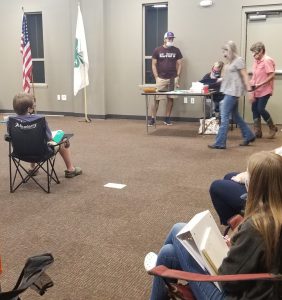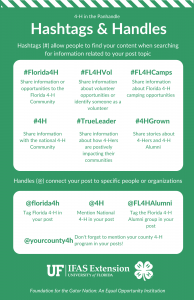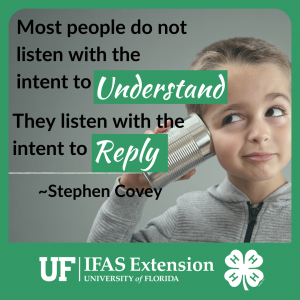by Heather Kent | May 14, 2021
 Parents, grandparents, and other family members are assets to the 4-H program. One of the best things about 4-H is that it promotes (and welcomes) family engagement! And there are benefits of family involvement- Duerden et al. (2013) found when adults were involved in youth programs, it strengthen family relationships and improved parent-child communication and bonding. Family involvement is a win-win-win for youth, adults and volunteers!
Parents, grandparents, and other family members are assets to the 4-H program. One of the best things about 4-H is that it promotes (and welcomes) family engagement! And there are benefits of family involvement- Duerden et al. (2013) found when adults were involved in youth programs, it strengthen family relationships and improved parent-child communication and bonding. Family involvement is a win-win-win for youth, adults and volunteers!
Make them Feel Welcome– Just like you would do for youth, make adults and other family members feel welcome!
- Encourage them to participate in get to know you games, or introduce them to other adults associated with the club.
- A parent meeting at the beginning of the club year is a great idea to help new parents feel like part of the group.
Communicate Clearly– Communicating with parents is essential. In fact, in a survey of new 4-H families in Florida, communication with the club leader was a major factor in whether or not the families returned to the program the following year (Hensley, 2020). Try these strategies to build strong communication with families.
- Set up clear lines of communication with parents by asking them how they prefer to receive communication. Some clubs use social media, texting apps (like GroupMe or Remind), or email. Find a method that works for your 4-H families.
- Make sure the club schedule works for everyone and that the location is accessible for all.
- Give each family a copy of the club program calendar, and ask another parent or club officer to send out reminders before meetings.
Help them Learn 4-H– 4-H is a large organization and has something for everyone, which is great! But it can also be a little overwhelming when you are new to the program.
- Explain the club cycle, such as when things normally occur during the year (service projects, fundraisers, competitions, awards programs, camp). That way, they can plan ahead and set goals for engagement.
- Ask a seasoned 4-H family to mentor a new 4-H family. This can help them learn about the program, and identify things that their children will want to participate in.
Discover their Skills, Knowledge & Interests– New 4-H families may think that they need special training or experience to contribute to the club. As a volunteer, let them know that we all “learn by doing” and everyone has something to contribute!
- Use the parent interest survey to find out how the adults might be willing to serve.
Identify Tasks and Make the Ask–
- Make a list of things that you need help with, then write each item on an index card (one item per card). Ask each family to select one or two items they are willing to be responsible for by writing their name on the back of the card.
Make Individual Asks for More Complex Tasks–
- Reach out to parents individually (when they are not distracted) and share some of the tasks you need help with that are a little more complex. For example, you may need a parent to help train club officers, teach parliamentary procedure or work with the service learning committee. Provide any resources they may need (such as an officer handbook or service learning guide) and let them know that the 4-H office will provide support for them in this role. If the task requires a level II background screening, then be upfront about that.
References:
Duerden, M. D., Witt, P. A., & Harrist, C. J. (2013, Winter). The impact of parental involvement on a structured youth program experience: A qualitative inquiry. Journal of Youth Development, 8(3), 1-17. Retrieved August 31, 2018, from jyd.pitt.edu/ojs/jyd/article/view/88.
Hensley, S. (2020). Florida 4-H Retention Study.
by Evie Hunter | May 6, 2021
 4-H club leaders are amazing instructors and terrific at running club meetings and events, but this job can be very time consuming. They deeply appreciate all the help they can get from the parents of the club members to help make the club even more successful. Even something as little as picking up snacks for a meeting or leading a group at a judging event can be a huge lifesaver. In addition, there are benefits to parent involvement. When parents, grandparents and other family members get involved in supporting 4-H clubs, it strengthens family relationships by improving “parent/child communication, bonding, and perceptions of one another” (Duerden, Witt, & Harrist, 2013). In addition, research shows that family involvement “prolongs the experience’s positive post-participation effects” (Duerden, Witt, and Harrist, 2013, p. 1).
4-H club leaders are amazing instructors and terrific at running club meetings and events, but this job can be very time consuming. They deeply appreciate all the help they can get from the parents of the club members to help make the club even more successful. Even something as little as picking up snacks for a meeting or leading a group at a judging event can be a huge lifesaver. In addition, there are benefits to parent involvement. When parents, grandparents and other family members get involved in supporting 4-H clubs, it strengthens family relationships by improving “parent/child communication, bonding, and perceptions of one another” (Duerden, Witt, & Harrist, 2013). In addition, research shows that family involvement “prolongs the experience’s positive post-participation effects” (Duerden, Witt, and Harrist, 2013, p. 1).
Aside from the benefits listed above, it is important to recognize reasons why parents volunteer. There are three types of motivation: achievement, affiliation and power (Atkinson and Feather, 1966). Henderson (1981) found most 4-H volunteers to be motivated by affiliation. Individuals motivated by affiliation value relationships with people and organizations. Affiliation-motivated volunteers would respond best to thank-you notes, verbal praise or informal “pats on the back.” One of the best ways to recruit parents or grandparents to help with clubs is to provide opportunities for them to develop positive relationships with other parents, members, and volunteers. Here are two simple suggestions for recruiting more parents and grandparents:
- When advising parents to sign their child up on 4-H Online, mention that they can also create their own profile so they can get involved as well. Make sure when you are recruiting new youth to your club, to also be very welcoming to their parents and encourage them to stay for the meetings and programs. Give them a copy of the club program calendar so they know when the meetings are and what is on the agenda.
- Introduce parents to other parents. Help them build connections with each other. Better yet, ask a more experienced parent to mentor new parents.
- Let parents know you welcome their involvement and give them the Parent Involvement Form. This form will allow parents the opportunity to see all of the different jobs and responsibilities that they can do to help the club succeed and sign up for the things that interest them. This will help you as a club leader to have a little less on your plate and allow the parents to help get involved with their child’s interests.
Every chance that you get to be involved in 4-H, whether you are a youth, parent, or club leader, you are giving your community a brighter future. All of the opportunities that 4-H provides will help build youth into positive members of society one day. So, club leaders, go out there and recruit the parents of your club members to help out and make your programs even stronger! Next week, we will talk about how to engage parents in your club!
References:
- Duerden, M. D., Witt, P. A., & Harrist, C. J. (2013, Winter). The impact of parental involvement on a structured youth program experience: A qualitative inquiry. Journal of Youth Development, 8(3), 1-17. Retrieved August 31, 2018, from jyd.pitt.edu/ojs/jyd/article/view/88.
- Atkinson, J., & Feather, N. (1966). Theory of achievement motivation. New York: Wiley.
- Henderson, K. (1981). Motivating the adult 4-H volunteer. Journal of Extension. 19(1). Retrieved from: http://www.joe.org/joe/1981january/81-1-a4.pdf
by Rachel Pienta | Apr 23, 2021
 The “secret sauce” for successful 4-H clubs is often the not-so-secret time management skill of the club leader. Time management is a learned skill. This week’s blog post will explore strategies for time management. One important detail about time management – what works for one person may not work for everyone. Choosing time management strategies that suit the person increases the likelihood that these skills will become permanent, frequently used tools in a personal “toolbox.”
The “secret sauce” for successful 4-H clubs is often the not-so-secret time management skill of the club leader. Time management is a learned skill. This week’s blog post will explore strategies for time management. One important detail about time management – what works for one person may not work for everyone. Choosing time management strategies that suit the person increases the likelihood that these skills will become permanent, frequently used tools in a personal “toolbox.”
Teaching Time Management Skills
One strategy to learn a time management skill is to teach it. Both club members and volunteer leaders can benefit from learning and practicing time management skills. Youth and adults alike can begin with some basic elements of planning to start developing time management skills.
To complete a time management activity during a club meeting, the following items will be needed: a weekly schedule template, a Post It adhesive flipchart or a white board/chalkboard, pencils/pens, scratch paper for note taking.
Write the five elements of S.M.A.R.T goals on the flipchart or white board:
S – Specific
M – Measureable
A – Attainable (or actionable)
R – Relevant (or realistic)
T – Time-bound
During this activity, participants will learn about time management, scheduling, and goal setting. Begin the activity with a task. Ask adults and youth to consider and write out their schedule for an average week. Use a weekly schedule template so that everyone can use a visual organizer to describe their individual schedules. There are a number of free schedule templates online. One free option is available from Microsoft office: https://templates.office.com/en-us/schedules.
Once everyone has completed their schedule, ask each participant to write down a personal goal related to school or 4-H. Then, explain the S.M.A.R.T goal concept. Next, ask everyone to consider their goal within the S.M.A.R.T framework. Does their goal fit the five elements of a S. M.A.R.T goal? Why or why not? If their goal needs to be adjusted, what changes should be made?
After discussing several different goals, ask everyone when the time is scheduled to work on achieving this goal. Spoiler alert: very few of the participants will include anything related to the goal in the initial weekly schedule draft.
During the next phase of this activity, introduce one or more time management strategies from the blog resource list to the group. Engage participants in discussion about which strategies might be effective for them than others.
Setting Individual Member and Club Goals
Conclude the meeting by setting short and long term goals. What do members want to accomplish by the next club meeting? What goals do club members want to achieve for the year?  Time management is a skill that can be practiced and improved throughout the 4-H club year. Be sure to schedule in time to report on progress toward goals as part of 4-H club business meetings.
Time management is a skill that can be practiced and improved throughout the 4-H club year. Be sure to schedule in time to report on progress toward goals as part of 4-H club business meetings.
Resources
by Julie McMillian | Mar 26, 2021
 If you are new to social media, it can seem a little overwhelming! Hashtags are a way to connect the social media content you post to a specific topic. They make it easier for the reader to find information around specific topics for further interest and conversation. After all- that is what social media is about- conversations! Even if you are using a private group, you can use specific 4-H hashtags and handles for your conversation. As you become more comfortable with using social media for your club, you should consider using hashtags. Both National 4-H Council and Florida 4-H have specific hashtags you can use as appropriate. This article breaks down the differences between hashtags and handles, when to use them, and includes a “cheat sheet” for 4-H specific hashtags and handles that you can use as a reference.
If you are new to social media, it can seem a little overwhelming! Hashtags are a way to connect the social media content you post to a specific topic. They make it easier for the reader to find information around specific topics for further interest and conversation. After all- that is what social media is about- conversations! Even if you are using a private group, you can use specific 4-H hashtags and handles for your conversation. As you become more comfortable with using social media for your club, you should consider using hashtags. Both National 4-H Council and Florida 4-H have specific hashtags you can use as appropriate. This article breaks down the differences between hashtags and handles, when to use them, and includes a “cheat sheet” for 4-H specific hashtags and handles that you can use as a reference.
Hashtags are words or phrases preceded by the “#” symbol that make your post searchable. For example, if people are looking for information about 4-H poultry programs, you can add the hashtag “4HPoultry” and your post will show up in their search. As you become more comfortable with using social media for your club, you should consider using hashtags. Both National 4-H Council and Florida 4-H have specific hashtags you can use as appropriate:
Example: You have a 4-H volunteer in your club who participated in 4-H activities as a youth and is now teaching your current club a hands-on specific skill. They are doing such as great job and you want to thank them in your Facebook group. You might use these popular hashtags: #FL4HAlumni #4HGrown #FL4HVOL
You can also use hashtags for events.
Example: 4-H Residential summer camp for youth in the panhandle is at Camp Timpoochee or Camp Cherry Lake. As you advertise or post about camp, you might use: #CampCherryLake #4htimpoochee #FL4HCamps
If you are the administrator of your group, you are able to pin hashtags on your group page that group members can easily see to generate interest. This can save time, so you don’t have to search through all posts and allow you to organize topics.
 Handles are the name of an individual or organization preceded by the “@” symbol. When you use a handle, it connects your post to that person or organziation’s page and can be seen by that person’s or organization’s friends or followers. Use the handle @Florida4H if you post has information relevant to the Florida 4-H population. It is always a good idea to use your county 4-H handle to connect your post to your county’s page and followers. For example, @yourcounty’sname4-H.
Handles are the name of an individual or organization preceded by the “@” symbol. When you use a handle, it connects your post to that person or organziation’s page and can be seen by that person’s or organization’s friends or followers. Use the handle @Florida4H if you post has information relevant to the Florida 4-H population. It is always a good idea to use your county 4-H handle to connect your post to your county’s page and followers. For example, @yourcounty’sname4-H.
by Julie McMillian | Mar 12, 2021
 As we look at the ever-changing social media journey, we think how can we keep up? Honestly, we probably never do and that’s okay. Social media can be an efficient way to communicate with 4-H families and also recognize the great things 4-Hers are doing! While you should never rely on only one form of communication to connect with every age group, social media can be an effective strategy. While Facebook is not the “go-to” platform for youth, most parents and community stakeholders are on Facebook. This article covers the basics of setting up a Facebook Group for your 4-H club the right way. Facebook is an approved platform through the University of Florida to use for 4-H, but there are some guidelines that need to be followed:
As we look at the ever-changing social media journey, we think how can we keep up? Honestly, we probably never do and that’s okay. Social media can be an efficient way to communicate with 4-H families and also recognize the great things 4-Hers are doing! While you should never rely on only one form of communication to connect with every age group, social media can be an effective strategy. While Facebook is not the “go-to” platform for youth, most parents and community stakeholders are on Facebook. This article covers the basics of setting up a Facebook Group for your 4-H club the right way. Facebook is an approved platform through the University of Florida to use for 4-H, but there are some guidelines that need to be followed:
1. Ask your local 4-H agent to be an administrator with you. Two sets of eyes are better than one and they can help you follow the right path for youth protection and be a resource for correct branding and logos. Also, if your 4-H agent is an administrator, it is really easy for him or her to share posts to the county 4-H page (when appropriate).
2. Create a Facebook Group instead of a Facebook Page for your club. Unlike Facebook Pages, you can change Group privacy settings and limit who can see information. Anyone can follow a Facebook Page whereas a Group can allow only approved members to see information. We must be sensitive to the personal information we share about our youth. How do I create a Facebook group? Steps for creating a FB Group
3. Follow the emblem guidelines for the proper use of University of Florida’s 4-H name and brands. UF IFAS Extension 4-H Graphics. Don’t forget that your club needs to be chartered in order to use the 4-H Name and Emblem.
4. Know who has a publicity release in your club. Youth with no photo release should not be shared in private groups and club leaders who will share information in the group must be aware of these limitations. Participation Release
5. If social media isn’t your “thing,” enlist help from another volunteer! You could also delegate responsibilities to one of the youth officers in your club to help with posting and interactions (with supervision of course).
Now you might be thinking what should a 4-H club talk about on Facebook? How will this Group be helpful? Here are a few ideas:
- Upcoming events
- Sharing of information and questions
- Advertisement for your club
- Fundraisers
- Recognize youth (if you have parental consent)
- Pictures, videos, and articles
- Challenges and surveys
- Information from the District and State programs
4-H volunteers are the true leaders who help our youth succeed by providing meaningful experiences every time programming is delivered. Our hope is that you feel empowered to incorporate positive engagement with youth by using relevant and innovative communication as technology advances. To learn more about incorporating social media for 4-H clubs or becoming a 4-H volunteer, join us next Thursday, March 18th at 6pm central/7pm eastern for our webinar on social media for 4-H clubs. You can also contact your local UF IFAS Extension Office UF IFAS Extension Office or visit Florida4-H.org.Social Media Tips
by Heather Kent | Jan 15, 2021
 Listening is a skill that can be learned, and is just as important (if not more so) than speaking. However, when it comes to teaching communication skills in 4-H, we have a tendency to focus on the speaking or writing part more than the listening part. So…we are kicking off our series on communication by focusing on this very important skill! This blog post will cover, how active listening can benefit adults and youth, tips for active listening, and some activities you can do with your 4-Hers to help them begin building and practicing solid listening skills.
Listening is a skill that can be learned, and is just as important (if not more so) than speaking. However, when it comes to teaching communication skills in 4-H, we have a tendency to focus on the speaking or writing part more than the listening part. So…we are kicking off our series on communication by focusing on this very important skill! This blog post will cover, how active listening can benefit adults and youth, tips for active listening, and some activities you can do with your 4-Hers to help them begin building and practicing solid listening skills.
Why focus on listening?
Listening and hearing are not the same- listening involves processing what you have heard, and for many people (including myself) it takes practice! A better description of listening well is active listening. Active listening requires the listener to fully concentrate, understand, respond, and, then….remember what is being said. Being a good listener also requires being mindful of what you are hearing. Mindfulness is paying attention in a particular way, on purpose, in the present moment – and non-judgmentally. The goal of mindful listening is to silence the internal noise of your own thoughts, so that you can hear the whole message, and so that the speaker feels understood.
Benefits of Active Listening

Infographic developed my Julie Dillard, Washington County UF IFAS Extension
There are several benefits to being a good listener.
- Prevent and resolve conflict
- Build trust
- Helps you learn
- Most importantly, good listening skills foster a sense of belonging, which is the most basic measure of a quality youth development program.
So how can we become better listeners? Here are a few tips:
• Just listen. Be attentive when you are listening. Do not let other thoughts, like what you are going to say in response, distract you.
• Express interest. Use eye contact, posture, and facial expressions to let people know you are interested in what they have to say and that you are ready to listen. Listening is a form of non-verbal communication, which we will delve more deeply into next week during our Virtual Volunteer Leadership Webinar.
• Reduce distractions. If possible, refrain from doing other tasks while you are listening so that you can focus on hearing what is being said.
• Listen for emotions. Emotions can be expressed through tone, but also through body language- what does the tone and body language of the person tell you? Are they expressing excitement, frustration, joy or sadness? Be very careful not to judge what the other person is feeling.
• Repeat it back. Once the person has finished talking, summarize what you heard and ask them to clarify if necessary.
• Don’t be afraid of silence. A silent moment allows the speaker and the listener to process what has been said through words, tone and body language.
How can we teach listening skills to youth?
Here are a few activities you can do virtually or in person with youth of all ages (and adults too). For instructions, click the link or read the instructions below the table. For more ideas, and strategies for non-verbal communication, sign up for our webinar series every third Thursday of the month at 6PM central, 7PM eastern.
| Activity |
Cloverbuds
(5-7 yrs.) |
Juniors
(8-10 yrs.) |
Intermediates
(11-13 yrs.) |
Seniors
(14-18 yrs.) |
Adults |
| Simon Says |
X |
X |
|
|
|
| Paper Tearing |
X |
X |
X |
X |
|
| Listening Inventory |
|
|
|
X |
X |
| Shh…Just Listen |
|
|
X |
X |
X |
| What’s your Problem? |
|
|
|
X |
X |
Paper-Tearing Exercise
1.) Pass out a sheet of paper to everyone and tell them the following: “We’re going to play a game that will show some important things about communication. Pick up a sheet of paper and hold it in front of you. Now, close your eyes and follow the directions I will give you—and no peeking! You cannot ask questions.”
2.) Give the following directions, carrying them out yourself with your own sheet of paper and pausing after each instruction to give the group time to comply:
• Fold your sheet of paper in half.
• Tear off the upper right-hand corner.
• Fold it in half again and tear off the upper left-hand corner.
• Fold it in half again and tear off the lower right-hand corner.
3.) After the tearing is complete, say something like, “Now open your eyes, and let’s see what you have. If I did a good job of communicating and you did a good job of listening, all of our sheets should look the same!”
4.) Hold your sheet up for them to see and discuss outcome.
• It is highly unlikely any sheet will match yours exactly.
• How are our papers different?
• Why don’t our papers match?
• How could a different communication method have helped us with this
activity?
Source: Strieter, L. (2008). Communications: Overview of Communications.
Shhhh. Just Listen…
1.) Work in pairs – Select one person to be the listener and one person to be the speaker.
2.) Challenge: The listener has to get the speaker to continue talking for five minutes, but can only make three statements during the time period. The speaker will talk about a situation that was a joyous occasion (ex. might be an award, a special event, a new job, etc.).
3.) Switch roles after five minutes.
4.) Return to whole group for reflection and discussion. The discussion that follows concentrates on how:
- The speaker felt when the person just listened and did not exchange information
- The nonverbal signals encouraged the speaker
- Uncomfortable the silence was
- It felt to just listen without having the pressure to contribute
- The speaker felt having the freedom to say whatever they felt
Source: Listening & Communication Exercises by Work Smart Blog, Posted online by Leslie Orr
http://blog.trainerswarehouse.com/communication -exercises
What’s Your Problem?
1.) Work in Pairs: One person is the listener and the other is the speaker.
2.) Role play: The listener practices active listening and tries to diffuse the tense situation. The speaker is upset because of [fill in any scenario].
3.) Discussion: The best way to diffuse a tense situation is to use active listening – it is important that the person knows you hear what they are saying. It is also important not to make any promises at that stage of the exchange. Acknowledge the person’s frustration and let them vent. Then, move on to problem solving – get the person to help in solving the problem and then work on solving it together.
Source: Listening & Communication Exercises by Work Smart Blog, Posted online by Tom Lord http://blog.trainerswarehouse.com/communication-exercises
 Parents, grandparents, and other family members are assets to the 4-H program. One of the best things about 4-H is that it promotes (and welcomes) family engagement! And there are benefits of family involvement- Duerden et al. (2013) found when adults were involved in youth programs, it strengthen family relationships and improved parent-child communication and bonding. Family involvement is a win-win-win for youth, adults and volunteers!
Parents, grandparents, and other family members are assets to the 4-H program. One of the best things about 4-H is that it promotes (and welcomes) family engagement! And there are benefits of family involvement- Duerden et al. (2013) found when adults were involved in youth programs, it strengthen family relationships and improved parent-child communication and bonding. Family involvement is a win-win-win for youth, adults and volunteers!






